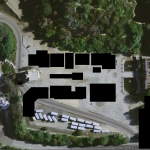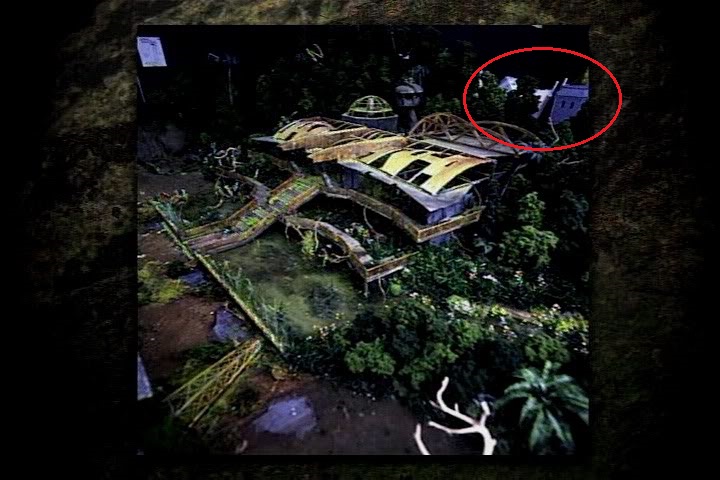 I was going through my library of images of the Worker Village, as I often do, when I noticed an interesting detail about the conceptual maquette model that was built of that area for the movie. This was a detail that I think explains a lot about Steven Spielberg’s decision making with the San Diego finale and how its presence in the final movie had been influenced by the 1960 Alfred Hitchcock movie, “Psycho.”
I was going through my library of images of the Worker Village, as I often do, when I noticed an interesting detail about the conceptual maquette model that was built of that area for the movie. This was a detail that I think explains a lot about Steven Spielberg’s decision making with the San Diego finale and how its presence in the final movie had been influenced by the 1960 Alfred Hitchcock movie, “Psycho.”
 One thing Steven Spielberg is known to do is that he likes to be able to conceptualize camera angles and shots in 3D. It was something he heavily did on “Raiders of the Lost Ark,” and something he did on “Jurassic Park” and “The Lost World: Jurassic Park” as well. In the lattermost’s case, a full mock up of the conceptualized Worker Village was built for Spielberg, complete with proposed set dressings. The diorama was built in a way that allowed Spielberg to not only plan out what he intended to be the finale of the movie, but the various buildings were swappable, and allow Spielberg to move buildings around on the model and change the concept as he pleased without having to wait for new art from the concept artists.
One thing Steven Spielberg is known to do is that he likes to be able to conceptualize camera angles and shots in 3D. It was something he heavily did on “Raiders of the Lost Ark,” and something he did on “Jurassic Park” and “The Lost World: Jurassic Park” as well. In the lattermost’s case, a full mock up of the conceptualized Worker Village was built for Spielberg, complete with proposed set dressings. The diorama was built in a way that allowed Spielberg to not only plan out what he intended to be the finale of the movie, but the various buildings were swappable, and allow Spielberg to move buildings around on the model and change the concept as he pleased without having to wait for new art from the concept artists.
 The problem with the original proposed placement of buildings in the Worker Village, however, begun nearly 40 years prior, with Alfred Hitchcock’s famous slasher movie “Psycho”. The Bates “Psycho” House sat right in the middle of where Spielberg planned to build his own movie set. Spielberg, being the movie buff he is, would probably never tear down such an important piece of movie history, and frankly I doubt Universal Studios would have let him if he tried. But there was still the matter of its presence. To the right is an image I put together a speculative silhouette mock up of what the above finished design would have looked like on the backlot. As you can see, it swallows the Psycho House within the limits of the Village itself. This means that the Village not only could not be built at this size, with this many buildings, but it could not face this direction. But I have discovered Spielberg’s solution.
The problem with the original proposed placement of buildings in the Worker Village, however, begun nearly 40 years prior, with Alfred Hitchcock’s famous slasher movie “Psycho”. The Bates “Psycho” House sat right in the middle of where Spielberg planned to build his own movie set. Spielberg, being the movie buff he is, would probably never tear down such an important piece of movie history, and frankly I doubt Universal Studios would have let him if he tried. But there was still the matter of its presence. To the right is an image I put together a speculative silhouette mock up of what the above finished design would have looked like on the backlot. As you can see, it swallows the Psycho House within the limits of the Village itself. This means that the Village not only could not be built at this size, with this many buildings, but it could not face this direction. But I have discovered Spielberg’s solution.
 Available on the special features of every physical home release of “The Lost World: Jurassic Park” since the collector’s edition VHS and DVDs in 1999 has been a slideshow of the conceptual diorama that Steven Spielberg had built for storyboarding. These images have thus far been of notoriously poor quality, however I have come across a version in satisfactory resolution that reveals Spielberg’s plans for the Psycho House. He wasn’t going to remove it, he was going to hide it. I had long suspected that this was going to be the solution, but had no evidence to support this idea. Beyond that, its location within the set was still problematic. The real trick wasn’t just that Spielberg was going to hide it, the trick was that the Worker Village was originally conceptualized facing the opposite direction in which it was built! The Psycho House was to be behind the Operations Building, hidden by fake large trees! This was Spielberg’s solution, and the answer to the Psycho House Problem!
Available on the special features of every physical home release of “The Lost World: Jurassic Park” since the collector’s edition VHS and DVDs in 1999 has been a slideshow of the conceptual diorama that Steven Spielberg had built for storyboarding. These images have thus far been of notoriously poor quality, however I have come across a version in satisfactory resolution that reveals Spielberg’s plans for the Psycho House. He wasn’t going to remove it, he was going to hide it. I had long suspected that this was going to be the solution, but had no evidence to support this idea. Beyond that, its location within the set was still problematic. The real trick wasn’t just that Spielberg was going to hide it, the trick was that the Worker Village was originally conceptualized facing the opposite direction in which it was built! The Psycho House was to be behind the Operations Building, hidden by fake large trees! This was Spielberg’s solution, and the answer to the Psycho House Problem!
 Unfortunately, the solution was not to be the final fix. As many fans well versed with the preproduction of “The Lost World: Jurassic Park” are aware, Spielberg still hadn’t made up his mind whether or not he wanted the Worker Village to be the set to his finale at all. A fan of the original 1933 “King Kong” since his childhood, Spielberg had always wanted to do a tribute to his favorite movie. In that, he and Koepp drafted a separate script with San Diego, California being the setting of a Kong-esque ending involving the male T. rex rampaging through the city. This would mean that, unfortunately, funds would not allow for a finished Worker Village if Spielberg decided to go with this new script ending.
Unfortunately, the solution was not to be the final fix. As many fans well versed with the preproduction of “The Lost World: Jurassic Park” are aware, Spielberg still hadn’t made up his mind whether or not he wanted the Worker Village to be the set to his finale at all. A fan of the original 1933 “King Kong” since his childhood, Spielberg had always wanted to do a tribute to his favorite movie. In that, he and Koepp drafted a separate script with San Diego, California being the setting of a Kong-esque ending involving the male T. rex rampaging through the city. This would mean that, unfortunately, funds would not allow for a finished Worker Village if Spielberg decided to go with this new script ending.
 The decision to reverse the direction of the Worker Village would also mean cutting out buildings from the planned set, and in the end it seems that the director’s nostalgia won out. Spielberg cut the Worker Village down to four buildings: the Gas Station, the Kiln House, the Boarding House, and the Operation Building, as well as a geothermal power section, which was all that remained of the big finale set piece. It’s apparent that the decision to change the ending was made prior to the construction of the Worker Village, and not during its construction as Spielberg has previously claimed. The Worker Village’s Operations Building was conceptualized with a large,
The decision to reverse the direction of the Worker Village would also mean cutting out buildings from the planned set, and in the end it seems that the director’s nostalgia won out. Spielberg cut the Worker Village down to four buildings: the Gas Station, the Kiln House, the Boarding House, and the Operation Building, as well as a geothermal power section, which was all that remained of the big finale set piece. It’s apparent that the decision to change the ending was made prior to the construction of the Worker Village, and not during its construction as Spielberg has previously claimed. The Worker Village’s Operations Building was conceptualized with a large,  watery pit at its entrance, somewhat like a moat, which was all that remained of a period of time during the conception process where it was proposed to partially build the Worker Village on a waterfront, near a waterfall. Apparently, this was deemed too impractical to accomplish within budget. Eventually, the construction crew broke ground, and it was ultimately decided to place the Operations Building in its final spot, at the opposite end of the exterior backlot from the Psycho House, where it could be safely hidden by palm fronds and the dark.
watery pit at its entrance, somewhat like a moat, which was all that remained of a period of time during the conception process where it was proposed to partially build the Worker Village on a waterfront, near a waterfall. Apparently, this was deemed too impractical to accomplish within budget. Eventually, the construction crew broke ground, and it was ultimately decided to place the Operations Building in its final spot, at the opposite end of the exterior backlot from the Psycho House, where it could be safely hidden by palm fronds and the dark.


